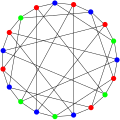Top Qs
Timeline
Chat
Perspective
Robertson graph
From Wikipedia, the free encyclopedia
Remove ads
In the mathematical field of graph theory, the Robertson graph or (4,5)-cage, is a 4-regular undirected graph with 19 vertices and 38 edges named after Neil Robertson.[2][3]
The Robertson graph is the unique (4,5)-cage graph and was discovered by Robertson in 1964.[4] As a cage graph, it is the smallest 4-regular graph with girth 5.
It has chromatic number 3, chromatic index 5, diameter 3, radius 3 and is both 4-vertex-connected and 4-edge-connected. It has book thickness 3 and queue number 2.[5]
The Robertson graph is also a Hamiltonian graph which possesses 5,376 distinct directed Hamiltonian cycles.
The Robertson graph is one of the smallest graphs with cop number 4.[6]
Remove ads
Algebraic properties
Summarize
Perspective
The Robertson graph is not a vertex-transitive graph; its full automorphism group is isomorphic to the dihedral group of order 24, the group of symmetries of a regular dodecagon, including both rotations and reflections.[7]
The characteristic polynomial of the Robertson graph is
Remove ads
Gallery
- The Robertson graph as drawn in the original publication.
- The chromatic number of the Robertson graph is 3.
- The chromatic index of the Robertson graph is 5.
References
Wikiwand - on
Seamless Wikipedia browsing. On steroids.
Remove ads






